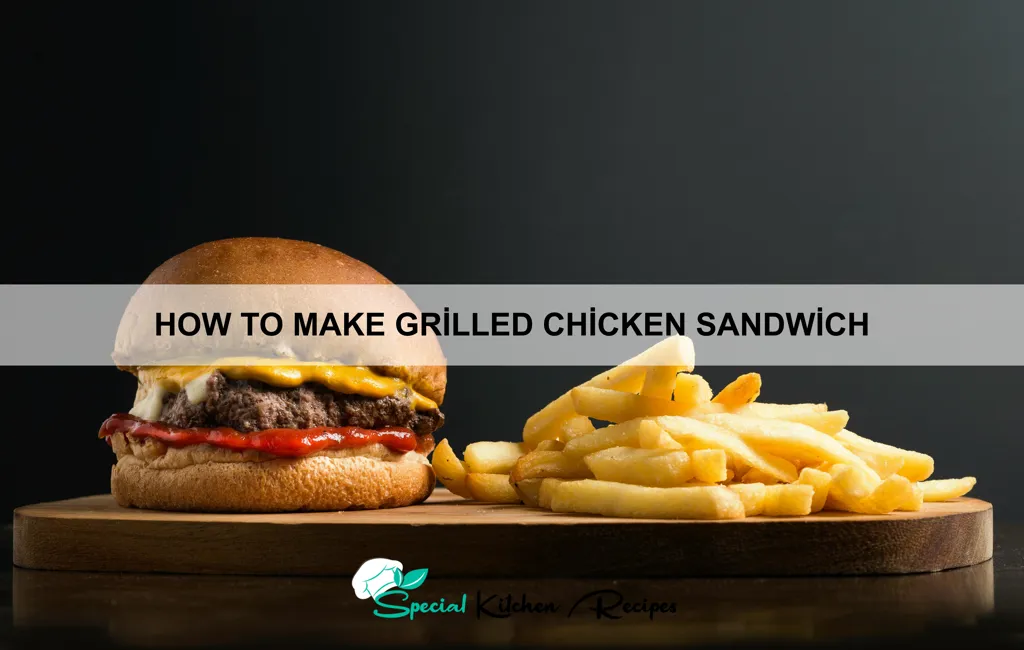The humble grilled chicken sandwich, a seemingly simple culinary creation, boasts a surprisingly rich and complex history, far exceeding its straightforward appearance. While pinpointing its exact origin is difficult, its rise to prominence is undeniably linked to the post-World War II boom in fast food and the increasing accessibility of readily available, affordable chicken. Unlike its beef-centric burger counterpart, which has a more clearly defined historical trajectory, the grilled chicken sandwich’s evolution has been a more gradual process, influenced by regional variations and changing consumer preferences. Its popularity truly exploded in the late 20th and early 21st centuries, becoming a staple menu item across fast-food chains and high-end restaurants alike.
The chicken sandwich’s appeal is rooted in its versatility. It’s a blank canvas, easily adaptable to diverse culinary traditions and personal tastes. From the classic simplicity of grilled chicken breast on a bun to more elaborate versions featuring gourmet sauces, artisan breads, and creative toppings, the possibilities are endless. This adaptability contributes to its global reach. While precise global consumption statistics are challenging to obtain, the sheer volume of chicken sandwiches sold daily in countless restaurants worldwide undeniably places it among the most consumed fast-casual meals. Estimates suggest that billions of chicken sandwiches are sold annually in the United States alone.
Culturally, the grilled chicken sandwich reflects several significant trends. It speaks to a growing demand for healthier fast food options, often perceived as a lighter alternative to burgers. Simultaneously, its widespread availability underscores the globalization of food and the standardization of certain culinary experiences across different cultures. However, it’s important to note that the grilled chicken sandwich experience can vary dramatically. In some cultures, it might be a simple street food, while in others it’s a carefully crafted culinary masterpiece. The remarkable journey of this seemingly ordinary sandwich truly highlights the fascinating interplay between culinary innovation, consumer trends, and global food culture.
Ingredients and Measurements
This recipe yields two delicious grilled chicken sandwiches. Accurate measurements are crucial for achieving the perfect balance of flavors and textures. We’ll start with the chicken, the star of the show.
Chicken: You’ll need 2 boneless, skinless chicken breasts, approximately 6 ounces each. Choosing quality chicken is key. Look for breasts that are plump, firm, and evenly colored. Avoid those with discoloration or an unpleasant odor. If your breasts are significantly larger or smaller, adjust cooking times accordingly. Thicker breasts will require longer grilling time to ensure they’re cooked through.
Marinade (optional, but highly recommended): A flavorful marinade will elevate your chicken to the next level. For this recipe, we suggest the following: 1/4 cup olive oil, 2 tablespoons lemon juice (freshly squeezed is best!), 1 tablespoon Dijon mustard, 1 teaspoon garlic powder, 1 teaspoon dried oregano, 1/2 teaspoon salt, and 1/4 teaspoon black pepper. Adjust seasoning to your preference; you can add more garlic, herbs, or even a touch of chili flakes for a spicier kick. Ensure the chicken is fully coated in the marinade and allow it to marinate for at least 30 minutes, or preferably 2-4 hours in the refrigerator for maximum flavor penetration.
Sandwich Components: For the perfect grilled chicken sandwich, you’ll need 4 slices of your favorite bread (brioche, sourdough, or ciabatta work wonderfully). We’ll also need 2 tablespoons of mayonnaise, 4 slices of your preferred cheese (cheddar, provolone, or Swiss are excellent choices), and your favorite toppings. Consider lettuce (about 2 cups of shredded or chopped lettuce), 1 medium tomato (sliced), and 1/2 of a red onion (thinly sliced). Feel free to customize your toppings with pickles, bacon, avocado, or any other additions you enjoy.
Important Note: These measurements are guidelines. Feel free to adjust quantities based on your personal taste and the size of your bread. For example, if you are using larger bread slices, you might need more chicken or additional toppings. Always ensure your chicken is cooked to an internal temperature of 165°F (74°C) to guarantee food safety.
Equipment and Utensils
Making a delicious grilled chicken sandwich requires the right tools. While you might be able to adapt with substitutes, having the proper equipment will significantly enhance the cooking process and the final product’s quality. Let’s break down the essentials.
First and foremost, you’ll need a grill. This could be a gas grill, charcoal grill, or even a grill pan suitable for stovetop use. For a gas grill, ensure it’s clean and preheated to medium-high heat (approximately 375-400°F or 190-205°C). If using charcoal, aim for a bed of hot coals with consistent heat distribution. A stovetop grill pan requires medium-high heat and a light coating of oil to prevent sticking.
Next, you’ll need tongs. These are crucial for safely handling the chicken during grilling and flipping it without tearing. Choose tongs that are long enough to keep your hands a safe distance from the heat source. A pair of 12-inch tongs is generally ideal.
Measuring cups and spoons are essential for accurate ingredient measurements. Ensure you have a set that includes at least 1 cup, ½ cup, ¼ cup, and 1 tablespoon measurements. Precision in measuring spices and marinade ingredients directly impacts the final taste.
A meat thermometer is highly recommended, especially if you’re unsure about the chicken’s internal temperature. A safe internal temperature for chicken is 165°F (74°C). Using a thermometer eliminates guesswork and ensures food safety. Avoid undercooked chicken at all costs.
For preparing the chicken and sandwich, you’ll need a large bowl for marinating, a cutting board, and a sharp knife for slicing the chicken. A spatula will assist in flipping the chicken on the grill, and a plate is essential for resting the cooked chicken before assembling the sandwich.
Finally, don’t forget about the sandwich-making components: a baking sheet or large plate for assembling the sandwiches, and sufficient quantities of your chosen bread, condiments, and toppings. Having all these utensils readily available will streamline the entire process, allowing you to focus on creating a perfect grilled chicken sandwich.
Professional Recommendation: Invest in high-quality tongs and a reliable meat thermometer. These tools will serve you well for years to come and will significantly improve your grilling experience and food safety.
Chicken Preparation (Marination/Seasoning)
The key to a juicy and flavorful grilled chicken sandwich lies in properly preparing the chicken before grilling. This involves selecting the right cut and creating a delicious marinade or seasoning blend. For this recipe, we recommend using boneless, skinless chicken breasts, approximately 1.5 lbs (680g) total, cut into approximately 1-inch thick slices. This ensures even cooking and prevents dryness.
Choosing your marinade is crucial. A simple yet effective marinade balances acidity, oil, and flavor. A good starting point is a mixture of 1/4 cup olive oil, 2 tablespoons lemon juice (freshly squeezed is best!), 1 tablespoon soy sauce (or tamari for gluten-free), and 1 teaspoon garlic powder. This provides moisture, tenderness, and a savory base.
Enhance your marinade with herbs and spices! Experiment with your favorites. Consider adding 1 teaspoon of dried oregano, 1/2 teaspoon of paprika, and a pinch of black pepper for a Mediterranean twist. For a spicier kick, incorporate 1/2 teaspoon of cayenne pepper or a few dashes of your favorite hot sauce. Remember to adjust the quantities according to your preference.
Proper marination time is vital. Place the chicken slices in a resealable plastic bag or shallow dish. Pour the marinade over the chicken, ensuring all pieces are coated evenly. Seal the bag tightly or cover the dish and refrigerate for at least 30 minutes. For optimal flavor and tenderness, marinate for 2-4 hours, or even overnight.
Alternatively, you can opt for a dry rub instead of a marinade. Combine 1 tablespoon paprika, 1 tablespoon garlic powder, 1 tablespoon onion powder, 1 teaspoon dried thyme, 1 teaspoon salt, and 1/2 teaspoon black pepper. Generously rub this mixture onto the chicken slices, ensuring complete coverage. Let it sit at room temperature for at least 30 minutes, allowing the flavors to penetrate.
Regardless of whether you use a marinade or a dry rub, remember to remove the chicken from the refrigerator 30 minutes before grilling. This allows the chicken to come to room temperature, promoting more even cooking. Do not skip this step! Cold chicken will cook unevenly, resulting in a dry and tough sandwich.
Finally, before grilling, pat the chicken dry with paper towels. This helps to achieve a nice sear and crisp exterior on the chicken.
Grilling the Chicken
Grilling chicken breasts for your sandwich requires attention to detail to ensure juicy, flavorful results. We’ll be grilling approximately 1.5 lbs of boneless, skinless chicken breasts, enough for two generous sandwiches. Before you begin, ensure your grill is clean and preheated to medium-high heat (approximately 375-400°F). You should be able to hold your hand about 6 inches above the grates for 4-5 seconds before needing to remove it due to the heat.
Pat the chicken breasts dry with paper towels. This crucial step helps achieve a beautiful sear and prevents sticking. Then, generously season both sides with salt and freshly ground black pepper. For added flavor, consider a simple rub of 1 teaspoon paprika, ½ teaspoon garlic powder, and ½ teaspoon onion powder per breast. Don’t overcrowd the grill; leave ample space between the chicken breasts for even cooking. If necessary, grill in batches.
Place the chicken breasts on the preheated grill grates. Avoid moving them for the first 3-4 minutes to allow a good sear to develop. This creates a delicious crust and helps lock in the juices. After the initial sear, use tongs to carefully flip the chicken breasts. Continue grilling, turning occasionally, for another 6-8 minutes, or until the internal temperature reaches 165°F. Use a meat thermometer to ensure accuracy; this is the only reliable way to guarantee the chicken is cooked through and safe to eat.
Pay close attention to the thickness of your chicken breasts. Thicker breasts will require longer grilling time. If the chicken is browning too quickly on the outside but hasn’t reached the desired internal temperature, you can reduce the heat slightly or loosely tent the grill with aluminum foil to slow down the cooking process. Once cooked through, remove the chicken from the grill and let it rest for 5-7 minutes before slicing. This allows the juices to redistribute, resulting in a more tender and flavorful sandwich.
Resting the chicken is just as important as grilling it properly. During this resting period, the muscle fibers relax, allowing the juices to redistribute evenly throughout the meat. Slicing the chicken immediately after grilling will release the juices, resulting in a dry sandwich. Once rested, slice the chicken breasts against the grain into thin strips for easy sandwich assembly. This ensures a tender bite and prevents tough, stringy chicken.
Preparing the Sandwich Components (Toppings, Bread)
The success of a grilled chicken sandwich hinges not just on the chicken, but also on the quality and preparation of its supporting cast: the bread and toppings. Let’s start with the bread. For the best results, choose a sturdy bread that can hold up to the juicy chicken and flavorful toppings without becoming soggy. A crusty artisan roll, a brioche bun, or even a toasted ciabatta are excellent choices. You’ll need two halves per sandwich, so plan accordingly. If using a larger loaf, slice it to approximately 1-inch thick slices.
Now, let’s move on to the toppings. The possibilities are endless, but we’ll focus on a classic combination that’s both delicious and easy to assemble. For this recipe, we’ll use: 4 slices of crisp bacon (cooked until desired crispness), 1/2 cup of shredded lettuce (Romaine or butter lettuce recommended for their crispness), 1/4 cup of thinly sliced red onion (soaking in ice water for 10 minutes to reduce sharpness is recommended), and 1/4 cup of sliced tomato. Remember to wash and thoroughly dry all your vegetables to prevent a soggy sandwich.
The quantity of toppings is a suggestion and can be adjusted to your preference. Some people prefer a more generous helping of bacon, while others might want more lettuce. The key is to achieve a balance; you want enough toppings to complement the chicken, but not so much that they overpower it. Consider the size of your bread when determining the quantity of toppings. A larger bun will accommodate more ingredients.
For the sauce, we’ll opt for a simple yet flavorful mayonnaise-based spread. Mix 1/4 cup of mayonnaise with 1 tablespoon of Dijon mustard and a pinch of salt and pepper. This creates a creamy and tangy sauce that perfectly complements the grilled chicken. You can also add other condiments to this base, such as a dash of hot sauce, or some finely chopped fresh herbs like parsley or chives for an extra layer of flavor.
Before assembling your sandwich, ensure all your components are ready. The bacon should be cooked and cooled slightly, the lettuce washed and dried, the onions soaked and drained, the tomatoes sliced, and the sauce prepared. Having everything prepped will make the assembly process quick and efficient, preventing your grilled chicken from cooling down while you’re busy preparing the toppings.
Assembling the Sandwich
With your perfectly grilled chicken breasts ready, it’s time to build the ultimate grilled chicken sandwich. The key here is balance – a harmonious blend of textures and flavors. We’ll be aiming for a sandwich that’s both satisfying and elegant.
Begin by taking two slices of your chosen bread. We recommend using a sturdy bread that can hold up to the juicy chicken and flavorful toppings without becoming soggy. A sourdough, ciabatta, or even a toasted brioche bun works wonderfully.
Spread approximately 2 tablespoons of your favorite mayonnaise or aioli on one slice of bread. Don’t overload; a thin, even layer is sufficient to add richness and prevent dryness. Consider adding a touch of Dijon mustard for an extra layer of flavor complexity – about ½ teaspoon per slice should do the trick.
Next, add your grilled chicken. Slice the chicken breast into approximately ¼-inch thick slices. This ensures even distribution of the chicken and prevents the sandwich from becoming too bulky. Arrange the chicken slices neatly across the mayonnaise-spread bread. Aim for about 4-5 ounces of chicken per sandwich, depending on your appetite.
Now for the toppings! Let’s get creative. A classic combination is lettuce, tomato, and onion. Use approximately 2 large leaves of crisp lettuce, 2-3 slices of ripe tomato, and ½ a small red onion, thinly sliced. Remember to wash and thoroughly dry your vegetables to prevent excess moisture from making the bread soggy.
If you’re using cheese, add it now. A sharp cheddar, provolone, or pepper jack all pair well with grilled chicken. One to two slices per sandwich is usually enough. Consider lightly grilling the cheese to melt it for an extra touch of deliciousness.
Finally, carefully top with the other slice of bread. Gently press down on the sandwich to ensure all the ingredients are nestled together, but avoid squashing the chicken or vegetables.
Your delicious grilled chicken sandwich is now ready! You can serve it immediately or cut it in half diagonally for easier eating. Enjoy!
Recommendations
For the best grilled chicken sandwich experience, we recommend using high-quality, boneless, skinless chicken breasts. Marinating the chicken for at least 30 minutes, or even overnight, will significantly enhance the flavor and tenderness. Experiment with different marinades, such as lemon-herb, honey-soy, or spicy chipotle, to find your favorite. Ensure the chicken is cooked to an internal temperature of 165°F (74°C) to guarantee food safety.
To elevate your sandwich, consider toasting the bun lightly before assembling. This adds a delightful crunch and prevents the bread from becoming soggy. Don’t overload the sandwich; a well-balanced combination of chicken, toppings, and sauce is key. Use fresh, high-quality ingredients for the best taste and texture. We suggest adding crisp lettuce, juicy tomatoes, and thinly sliced red onion for a refreshing contrast. Consider adding cheese, such as cheddar, Swiss, or pepper jack, for extra flavor and richness.
Serving suggestions abound! A simple side of potato chips or coleslaw complements the sandwich perfectly. For a healthier option, serve it with a fresh garden salad or a side of roasted vegetables. For a complete meal, consider adding a side of fruit, such as a sliced apple or grapes, for a balanced and satisfying experience.
Leftover grilled chicken sandwiches should be stored in an airtight container in the refrigerator for up to 3 days. To maintain freshness and prevent the bread from becoming soggy, it’s best to store the chicken and toppings separately and assemble the sandwich just before serving. Reheating can be done in a microwave or toaster oven, but be careful not to overcook the chicken.
Nutritional Information (per serving, approximate): Calorie count will vary depending on ingredients and portion size. A typical grilled chicken sandwich (using a whole wheat bun, 4oz chicken breast, lettuce, tomato, and a light spread of mayonnaise) might contain approximately 450-550 calories. This includes protein from the chicken, carbohydrates from the bun, and some fats and vitamins from the other ingredients. The exact nutritional breakdown will depend on the specific ingredients used. For a more precise nutritional analysis, use a nutrition calculator with the exact ingredients and quantities.





